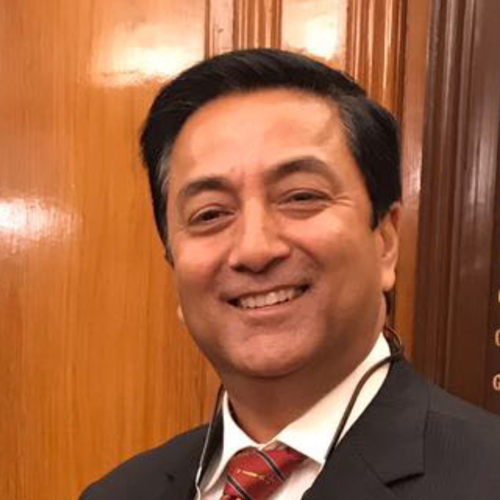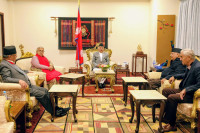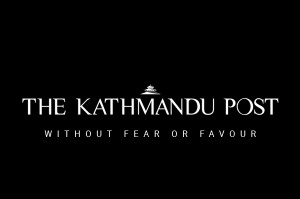Valley
National security
Nepal needs to identify ways to counter domesticand regional challenges and threats
Binoj Basnyat
Nepal lacks direct access to the sea, which poses a great challenge for trade and transport. Its landlocked nature has also resulted in poor infrastructure, a fragile political and securitysituation and costly administrative practices. We need to observe and define security trends in Asia Pacific and particularly South Asia, and identify methods to counter domestic and regional challenges and threats.
The root of Nepal’s predicament lies in the lack of a strategic organisation for national security, effective administrative management and national policies for diplomatic approach besides politicisation of all institutions. The transition from a monarchy to a republic, a Hindu kingdom to a secular state and development regions to federal states has been anarchic, but hopeful. A national security strategy with a strategic structure is fundamental to safeguarding Nepal’s national interest. So an apex body for the quest of national interest is the need of the day.
Securing national interests
The national security strategy should include Nepal’s vision for an incorporated national security arrangement that safeguards the nation, envisages challenges and threats and contributes to domestic and regional stability. The four pillars of national security are protecting and strengthening sovereignty, ensuring a safe and resilient population, securing our assets, infrastructure and institutions, and promoting a favourable regional and international environment.
First of all, a primary reason why Nepal exists is to promote national purposes. It can also be argued that national purposes should guide all state policies, domestic and foreign. Two, Nepal’s national interests should be defined by including geography, history, culture, thepolitical system and economic and security issues.
Three, national objectives tend to be more tangible and easier to change. The structured agencies should work to achieve five objectives: promoting a secure international and regional peace and stability by countering terrorism, espionage and foreign interference, and preventing, detecting and disrupting serious organised crime; promoting national peace and stability by strengthening the resilience of the people, assets, infrastructure and institutions, deterring and defeating attacks on Nepal and its interests and preserving the country’s integrity; promoting national values and ideology with political stability; establishing good friendly relations with neighbouring countries; and achieving economicdevelopment with maximumutilisation of natural resources to eradicate poverty.
Four, the national policy is an action designed to attain a specific objective. In military terms, a policy is simply a course of action. Several alternative courses of action may be developed to secure an objective. For example, if Nepal’s objective in South Asia is to curb radicalism and secure the territory from being used against the two neighbours, an appropriate policy would be to provide related intelligence and law enforcement agencies to look into the issue.
Lastly, policy is followed by commitments that specify interest and objectives in a given situation. Commitments may be secret or public, and they may reflect policy that is clarified through action. Commitments are expressed in treaties, executive agreements, speeches by top officials, legislation and parliamentary resolutions. A programme is the tangible proof of a commitment. A programme usually indicates a precise amount of resources to be used and the timeframe within which it will be in operation.
Two strategic structures
Understanding what structures and capabilities we possess allows the legislative and executive branches to consider what tasks and responsibilities the organisation can take on. The Prime Minister’s Office (PMO) should create two strategic structures enabling the flow of power and authority to be based on hierarchical levels. One, a powerful secretariat should be created with professional merit, non-elected officials and an administrative policy making group to monitor the plans and commitments of the PMO and inspire the behaviour of civil servants. Two, national and international security issues should be dealt with by reordering and rearranging the National Security Council (NSC).
The NSC should be the apex body with a national security advisor, a chief executive and a deputy national security advisor with direct control and authority of the prime minister. Its responsibilities are to “advise the prime minister on national and international security to enable all the ministries, departments and agencies of the government to cooperate more effectively in matters relating to policy including diplomatic, military, economic and informational”.
The security management system includes the Strategic Policy Group (SPG), the Joint Intelligence Committee (JIC) with a secretariat from all intelligence units or the current NSC and a third-tier National Security Advisory Committee (NSAC). The SPG should include the chief secretary, chief of forces,chief of the newly formed intelligence under the prime minister, governor of Nepal Rastra Bank, commissioner of the National Planning Commission and the secretaries of all the ministries.
The SPG will undertake strategic reviews of short- and long-term national security challenges. Sub-groups with the deputies of the SPG will meet once a month for detailed planning and progress reporting. The NSAC will be filled with experts and persons of eminence outside government to provide long-term forecasts and analysis to the NSC. Nepal will have to place greater emphasis on intensifying relationships by accommodating the entire government machinery and non-governmental segments. The country will continue to alter the strategic structure and support fragile and vulnerable areas to promote regional and international stability.
Basnyat is a political and security analyst and a retired Army Major General




 18.12°C Kathmandu
18.12°C Kathmandu











